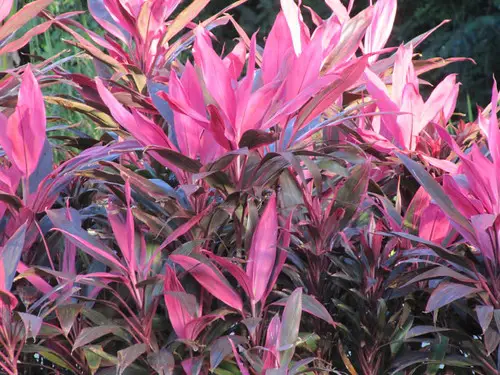Cordyline is a unique and diverse genus of plants that includes approximately 15 species, most commonly found in the Pacific region, New Zealand, Australia, and Southeast Asia. With striking foliage that ranges in color from rich green to deep reds and purples, Cordyline plants are a popular choice for ornamental gardens, borders, and container planting. Their sword-like leaves add a touch of exotic flair to the landscape.
Known for their tolerance of various environmental conditions, Cordylines are often seen in coastal areas where they can withstand salty winds and sandy soils. The flowers, though not the main attraction of the plant, can be quite beautiful, forming panicles of small fragrant blossoms that attract bees and butterflies.
Several species and cultivars of Cordyline are used in different cultures for medicinal purposes or even in ceremonies. The root of some species has been traditionally used to produce a fermented drink in various Pacific islands. Whether for its appearance or cultural significance, Cordyline is a plant with many layers of interest.
| Attribute | Details |
|---|---|
| Common Names | Cabbage Tree, Palm Lily |
| Botanical Name | Cordyline |
| Family | Asparagaceae |
| Plant Type | Evergreen shrub or tree |
| Mature Size | 3-20 feet, depending on species |
| Sun Exposure | Full sun to partial shade |
| Soil Type | Well-drained, fertile soil |
| Hardiness Zones | 8-11 |
| Native Area | Pacific region, New Zealand, Australia, Southeast Asia |
Cordyline Care
Caring for Cordyline is generally straightforward, though attention to its preferred conditions will yield the best results. They enjoy well-drained soil, enriched with organic matter, and require regular watering, especially during the growing season.
These plants are usually pest-free and don’t demand extensive care, making them suitable for gardeners at all levels of experience. However, they can be susceptible to leaf spot, especially when humidity levels are high, so it’s crucial to monitor the plant regularly for any signs of disease.
Light Requirement for Cordyline
Cordyline thrives in a position that offers full sun to partial shade. While it can tolerate some degree of shade, providing ample sunlight encourages vibrant leaf color and overall health.
Soil Requirements for Cordyline
Cordyline prefers well-drained, fertile soil that retains some moisture. Incorporating organic matter into the planting site can improve the soil structure and promote healthy growth.
Water Requirements for Cordyline
Regular watering is essential for Cordyline, particularly during the growing season. However, it’s important not to over-water, as soggy soil can lead to root rot. Adequate drainage should be ensured to avoid this issue.
Temperature and Humidity
Cordyline plants enjoy warmth and thrive in temperate to tropical climates. They can tolerate temperatures as low as 15°F for brief periods but are best suited to hardiness zones 8-11. High humidity is generally well-tolerated, although it can lead to leaf spot disease.
Fertilizer
Feeding Cordyline with a balanced, slow-release fertilizer in the spring encourages vibrant growth. Repeat the application in mid-summer for optimal results.
Pruning Cordyline
Pruning Cordyline helps in maintaining shape and promoting new growth. Remove dead or damaged leaves as needed, and trim back the plant in early spring if necessary.
Propagating Cordyline
Cordyline can be propagated through stem cuttings or by division of the clump. Stem cuttings should be taken in spring and placed in a well-draining potting mix.
How To Grow Cordyline From Seed
Growing Cordyline from seed is a longer process. Sow seeds in a seed-raising tray filled with seed-raising mix and keep moist until germination occurs. Once the seedlings are large enough, they can be transplanted to their final location.
Common Pests & Plant Diseases
Aphids
Aphids can be treated using insecticidal soap.
Spider Mites
Control spider mites by increasing humidity or using miticides.
Leaf Spot
Leaf spot can be managed by proper spacing and avoiding overhead watering.
Common Problems With Cordyline
Yellowing Leaves
Yellowing leaves might indicate over-watering. Check soil and reduce water if necessary.
Leggy Growth
Leggy growth often occurs due to insufficient light. Consider moving the plant to a sunnier location.
Pro Tips
- Plant Cordyline in a mixed border for a tropical effect.
- Pair Cordyline with plants that have contrasting leaf shapes for visual interest.
- Avoid planting Cordyline in locations with heavy, poorly-draining soil.
- Monitor the plant regularly for signs of pests or diseases for early intervention.
- Cordyline can make a dramatic statement in large containers on patios or decks.




